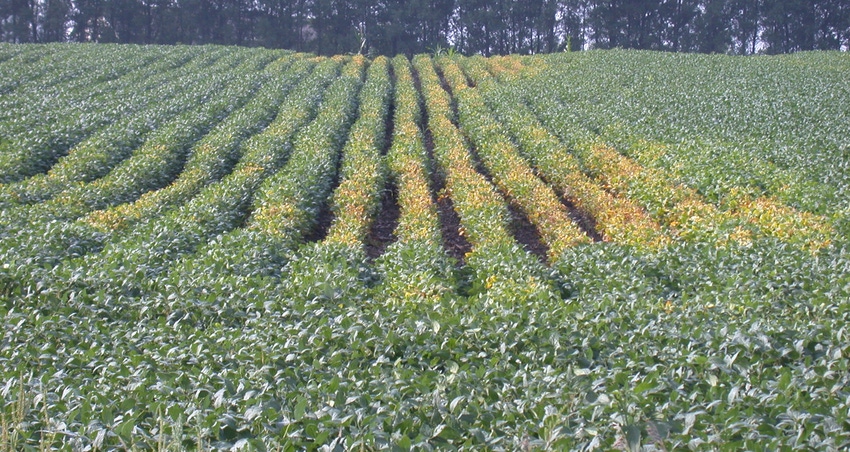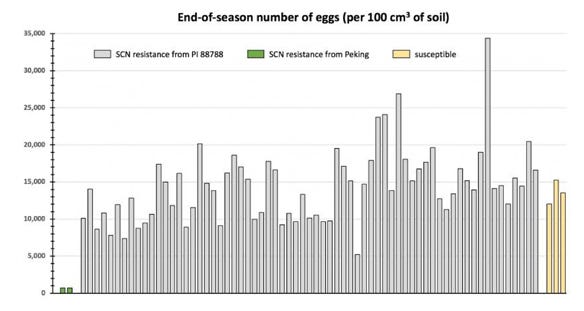January 15, 2020

The results of a field experiment conducted in 2019 with soybean cyst nematode in southeast Iowa were dramatic and alarming. The data illustrate what likely could occur in SCN-infested fields throughout the state in future years.
The experiment measured yield and SCN control of 67 soybean varieties, with SCN resistance from the commonly used breeding line PI 88788 and two varieties with the alternative, hard-to-find Peking SCN resistance, plus three susceptible varieties for comparison. The varieties were grown in a field with a moderate SCN egg count, and the SCN population had elevated on varieties with PI 88788 resistance. Only two varieties with Peking SCN resistance were in the experiment because few varieties with that source of resistance are available in the marketplace for farmers to plant.
The southeast Iowa yield trial was one of nine conducted at various locations throughout Iowa. Iowa State University Extension nematologist Greg Tylka and his team conduct the SCN yield tests annually. This research is supported by soybean checkoff funds from the Iowa Soybean Association.
Peking outperforms PI 88788
The susceptible soybean varieties in the southeast Iowa trial had an average yield of 41.8 bushels per acre (yellow bars in chart below). Yields of the varieties with PI 88788 SCN resistance (gray bars) ranged from 41.0 to 58.7 bushels per acre and averaged 51.2 bushels per acre. The highest-yielding variety with PI 88788 SCN resistance produced 58.7 bushels per acre. The two varieties with Peking SCN resistance (green bars) yielded 71.3 and 73.5 bushels per acre, averaging 72.4 bushels per acre.

This bar chart shows yields of the 72 soybean varieties in the test near Fruitland. SCN-resistant varieties are listed in decreasing order of yield from highest (left) to lowest (right), followed by susceptible varieties on the far right. There were three susceptible soybean varieties (orange bars), 67 varieties with SCN resistance from PI 88788 (gray bars), and two varieties with Peking SCN resistance (green bars) in the trial.
Full results from this southeast Iowa yield test and the eight similar trials conducted in other areas of Iowa in 2019 are available online here.
The soil in the area of the southeast Iowa field where the test plots were located had 4,687 SCN eggs per 100 cubic meters of soil at the beginning of the season. This is a moderate egg count. The average number of eggs in the soil at the end of the season for the three susceptible soybean varieties averaged 13,600 eggs per 100 cm3 of soil (see bar chart below, same color scheme as yield chart above).
Peking reduces SCN population
The end-of-season SCN population density for PI 88788 varieties ranged from 5,225 to 34,400 eggs per 100 cm3 and averaged 14,432 per 100 cm3. There were 10,100 eggs per 100 cm3 of soil at the end of the season for the top-yielding PI 88788 variety. And in contrast, there were fewer than 800 eggs per 100 cm3 of soil at the end of the season with the two Peking SCN-resistant soybean varieties.

This chart shows end-of-season SCN egg numbers for the 72 soybean varieties in the southeast Iowa trial. There were three susceptible soybean varieties (orange bars), 67 varieties with SCN resistance from PI 88788 (gray bars), and two varieties with Peking SCN resistance (green bars) in the test. The initial SCN egg population density in the experiment was 4,687 SCN eggs per 100 cm3 of soil. These egg count results for the varieties are listed in the same order as shown in the yield chart.
Alarming, but not surprising
Farmers have used resistant soybean varieties to manage SCN for decades. There are hundreds of resistant varieties available. Almost all have SCN resistance genes from the PI 88788 breeding line (see here). Fewer than 5% of SCN-resistant soybean varieties for Iowa have the alternative source of resistance named Peking.
Continual use of resistance from the PI 88788 breeding line has forced SCN populations to develop increased levels of reproduction on resistant varieties. Elevated reproduction of SCN populations on PI 88788 resistance is well documented throughout Iowa and most of the Midwest. So, although these results are alarming, they are not surprising. SCN is becoming increasingly resistant to the PI 88788 resistance trait.
The farmer who hosted the SCN variety trial in southeast Iowa grew two different soybean varieties with PI 88788 SCN resistance in the remainder of the field surrounding the experiment, and the varieties yielded 50 bushels per acre. If one of the varieties with Peking SCN resistance in the experiment had been grown in the field, the farmer would have earned nearly $200 per acre more (based on 22 bushels per acre yield difference between the Peking varieties and the PI 88788 varieties grown by the host farmer and $9 per bushel soybeans).
“These results were very consistent and statistically significant,” Tylka says, “and they illustrate the staggering amount of yield loss that can be caused by SCN when resistance from PI 88788 is overcome.”
Problem must be addressed
Many fields in Iowa are similar to this southeast Iowa field, Tylka says. The only difference between the field where the experiment was conducted and most SCN-infested fields in Iowa is that this southeast Iowa field had well-drained, sandy soil, and the dry soil conditions that occur in this texture of soil favor SCN reproduction and yield reduction.
Very large differences in yields of soybean varieties with PI 88788 and Peking SCN resistance may not commonly occur in fields with medium- and heavy-textured soils in Iowa — at least not yet. But results like this are possible in any SCN-infested field with any soil texture, especially under dry growing conditions, he adds.
“Presently, most soybean varieties have PI 88788 SCN resistance, and it is inevitable that yields of these varieties will continue to decrease in fields infested with SCN because reproduction of nematode populations on PI 88788 will steadily increase,” Tylka warns. “The trend will continue until soybean varieties with Peking resistance are commonly and widely grown in rotation with PI 88788 SCN resistance in SCN-infested fields, which is not possible to do currently because very few soybean varieties with Peking SCN resistance are available.”
For now, farmers should actively seek out the few soybean varieties with Peking resistance that are available and grow them in SCN-infested fields, he advises, “even if the seed has to be purchased of a brand you don’t normally grow. Also, farmers are strongly encouraged to persistently ask for SCN-resistant varieties with Peking SCN resistance from their seed providers. New soybean varieties with Peking resistance likely will not become plentiful until farmers voice the need.”
How to overcome resistance
Over the years, continuous planting of soybean varieties with the PI88788 resistance trait has caused soybean cyst nematode to develop resistance to SCN-resistant soybean varieties. Research by Iowa State University nematologist Greg Tylka shows that SCN populations can increase in aggressiveness with repeated plantings of SCN-resistant soybeans that have the PI 88788 source. In reviewing this increasing problem and the action needed to keep it from growing worse, he makes these key points:
Hundreds of soybean varieties have SCN resistance from the breeding line PI 88788; few have resistance from a breeding line named Peking.
Most SCN populations in Iowa have developed increased levels of reproduction on PI 88788 resistance.
In a field experiment in southeast Iowa in 2019, 67 varieties with PI 88788 SCN resistance yielded 41 to 59 bushels per acre; two varieties with Peking SCN resistance averaged 72 bushels per acre.
Soybeans with PI 8878 SCN resistance grown in the field surrounding the experiment yielded 50 bushels per acre.
Nearly $200 per acre more would have been earned if a variety with Peking SCN resistance from the variety trial had been grown in the field.
Farmers must seek out soybean varieties with Peking SCN resistance to grow in rotation with varieties that have PI 88788 resistance.
Farmers should persistently request soybean varieties with Peking SCN resistance from seed providers to grow in rotation with PI 88788 resistance.
Source: ISU, which is solely responsible for the information provided and is wholly owned by the source. Informa Business Media and all its subsidiaries are not responsible for any of the content contained in this information asset.
You May Also Like




